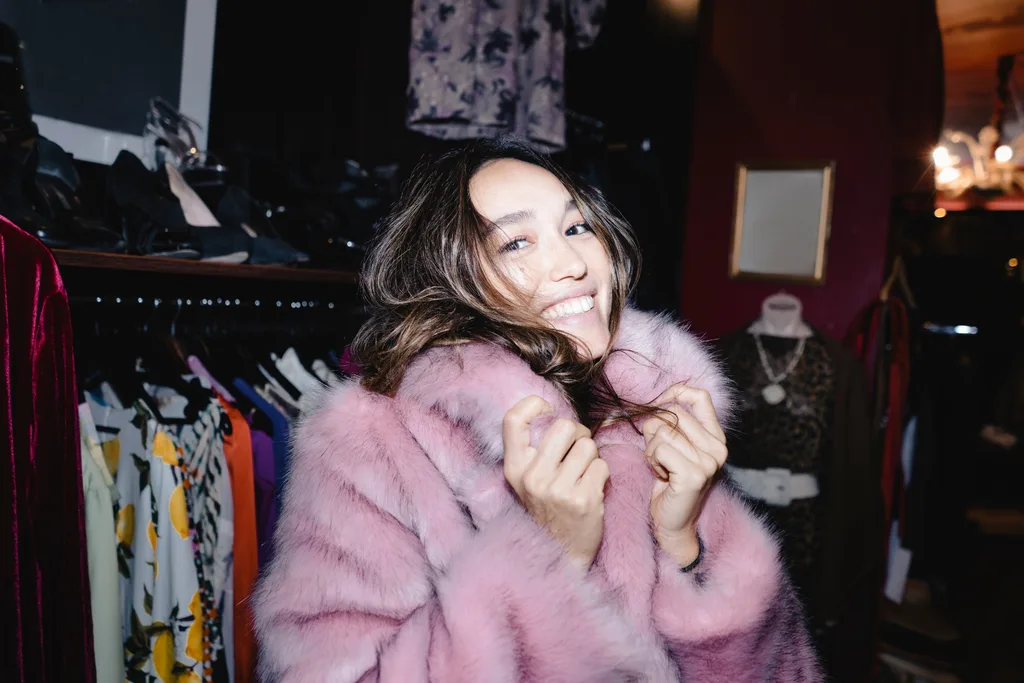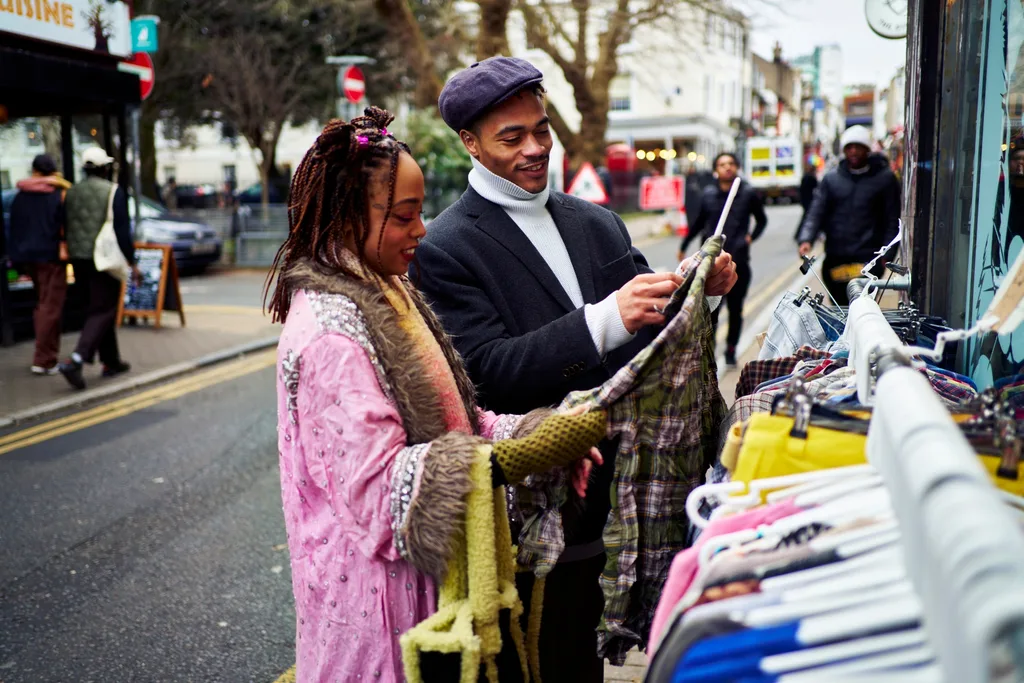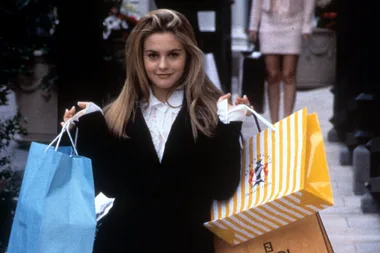Finding that second-hand pair of Prada slingbacks or a Louis Vuitton Speedy bag might still be the holy grail of thrift shopping, but increasingly Australians are satisfied with a vintage surf tee or perfectly worn-in Levi’s.
“I recently purchased a Marks & Spencer navy blazer at Lifeline in Manly [northern Sydney] for $25. Whenever I wear it I always get compliments,” says Anne Bluett, a
seasoned second-hand shopper.
The thrill of the chase and a love of a bargain has long fuelled the thrift economy, but as the acceptance of buying second-hand has grown – driven largely by Gen Z – increasingly there are those who are making a living or at least a good side hustle from selling thrifted fashion items. Other businesses have built up to help sellers clear out their wardrobes without the hassle of organising a market stall or dealing with hagglers on Gumtree.

Five months after her first sale on Depop, Sally Paton became a top seller on the resale platform beloved of Gen Z – which has also been labelled the Depop Generation. She had previously worked as a model and then as a fashion writer, but after quitting a writing job in Los Angeles she returned to Perth unsure of her next career move.
“I started doing Depop as a side hustle, selling pieces from my wardrobe,” Paton tells marie claire. “It’s kind of a combination of everything I’ve ever done. I modelled for a decade and learnt how to take cool photos on set. And I had a lot of designer stuff from my modelling days. I was getting really busy, so I started thrifting and it just grew. At the moment, it is literally my full-time gig – it’s crazy.” By selling 20 to 25 items a week, sourced largely from op shops, Paton says she earns “a fine income for now”.
Why Buy Second Hand?
For the thrift economy, the only way is up. American online second-hand platform ThredUp’s Resale Report 2023 estimates that the global second-hand market is set to almost double by 2027, reaching $US350 billion ($541 billion). It believes that by next year, 10 per cent of the global apparel market will be made up of second-hand clothing.
In addition, it anticipates that the second-hand market will grow at a rate three times faster than that of the mainstream apparel market.
Search for #thrifthaul on TikTok and you’ll find more than 4.2 billion views of people showing off their latest finds, from fashion to homewares or random second-hand treasures, such as a wicker giraffe for their entry hall. Instagram isn’t immune either, with more than 950,000 posts for the same hashtag.
The social media frenzy, like the trend itself, is largely being driven by Gen Z. The ThredUp report says that sustainability is a top five motivator for this generation of shoppers, and that more than half of Gen Z and Millennials would forgo an on-trend look in favour of something no-one else had.
This plays into research undertaken by Dr Louise Grimmer, a senior lecturer in marketing and retail at the University of Tasmania. In 2022, she co-authored a paper titled Consumer Orientations of Second- hand Fashion Shoppers: The Role of Shopping Frequency and Store Type. More than 500 female-identifying participants across a broad age and demographic range were interviewed for the research. Grimmer and her co-writers were curious about what actually made people purchase this way, whether from charity or consignment stores or online platforms such as Depop, eBay or Facebook Marketplace.

“We all say we’re interested in sustainability and environmental responsibility and want workers to be treated properly, but all that goes out the window when we make a purchase,” she tells marie claire. “We wondered, what is driving people to buy second-hand clothes? Is it environmental consciousness or frugality?”
To find out, they tested consumer orientation against a number of measures: ecological consciousness, frugality, materialism, nostalgia proneness, style consciousness, and fashion consciousness. “We found that out of all those orientations, people who shop second-hand rate style consciousness the highest,” says Grimmer. “People want to express who they are through their clothes and the things they have in their home, and they look for timeless, classic pieces and those things are now found in second-hand stores.”
Brooke Eichhorn, eBay’s head of fashion, concurs: “I think being style conscious rather than fashion conscious really breeds that thrifter mindset – ‘I’m going to go and find that item that doesn’t look like what everyone else has on the high street.’ It’s about finding that unique style.”

Sally Paton targets the sweet spot between what’s currently in fashion and what is unique to the customer from a vintage perspective. “Y2K is massive on Depop, so surf brands from the 2000s, like Bad Boy or Bad Girl, sell for way too much money, [as do] Y2K slip dresses,” says Paton.
“Ballet flats are now back. I look at what I see on influencers, on runways and try to find suitable stuff in op shops. I’m obsessed with fashion and if it’s high-quality, good fabric, a good fit, I’ll buy it. I don’t even buy new stuff anymore. A lot of people want something no-one else has. Depop or op-shopping are sick for that.” Geography teacher Leisa Mackey buys and sells on eBay, and is instilling a love of pre-loved fashion in the next generation of shoppers via class swap meets. “The students love it,” she says. “The teenage boys get into it more than the girls. The boys think it’s so cool. Everything ’90s is back again, and they’re like, ‘Miss, have you still got this? Can I have it?’”
Thrifting Is Good For The Environment Too…
It sometimes feels that the world and our wardrobes are drowning in clothes. According to new research from the Australian Fashion Council, every year Australians buy 14.8kg of clothing – and send 10kg to landfill.
We’ve seen the documentaries where second-hand clothing from Western countries is sent to African marketplaces, and what is left unsold ends up clogging rivers and festering in enormous landfill piles. When she was writing about sustainability, Paton recalls interviewing a digital designer living in Nigeria: “She lived right near a landfill that was all fashion. It’s disgusting having a pile of rotting clothes so close to your house.”
While the hunger for new fashion to post on TikTok and Instagram is rife among the younger generations, Paton believes that buying second-hand wins sustainability points for keeping clothes out of landfill. “I love fashion and want to have cute clothes and a new outfit, and if that’s you [too] then find a way to be better about it,” she says. “There’s always a sustainable aspect to Depop. Some customers ask if you send things in sustainable mailers. For some people it is a top priority, which is so awesome. Also, heaps of young people are on there trying to find a bargain. My phone is blowing up all day.”
For Melbourne novelist Imbi Neeme, thrifting has been a passion and pastime for more than 30 years. Her journey started for reasons of frugality and has ended up being more about sustainability. “Also, I think the thing missing [in the conversation] is the thrill of the chase,” says Neeme. “It’s that complete satisfaction of finding a gem.”
Neeme concedes that her wardrobes are now overflowing with clothing. “I’m not a hoarder but I am overly nostalgic and attached to items,” she says. “But because I know how little
I spend on clothes compared with the average person, I don’t feel too bad and I figure I’m helping a charity, saving money and fulfilling some quest- focused part of my brain. I can see the value in it: I get more bang for buck.”

In a bid to add more value to her thrifting, Neeme is undertaking a course at the Footscray School of Sewing & Upcycling, learning to mend or alter items to fit her perfectly or make new items to measure – often from thrifted fabrics and buttons.
Mackey also sews, which she says is a bonus in the second-hand economy. “When I initially started buying online I was more cautious, but now I have more idea about brands and quality,” she says. “If people say something is faulty or has something missing, I’m confident in being able to repair that. Op shops are a goldmine of things people think are too broken.”
In terms of clearing out her own pre-loved items, Neeme usually takes pieces back to charity shops or gives to friends who will use them. She was put off selling due to the admin and having to deal with so many potential buyers. This is where Sydney-based initiative SwapUp comes in.
Similar in concept to ThredUp, it’s a platform that sells pieces from individual sellers for a sliding commission depending on the item’s value. The advantage is that they do all the photography, pricing and quality checks for you.
“When we started the business, we interviewed customers and asked why they choose to sell with us,” says Alifa Putri, co-founder of SwapUp. Pricing and the back-and-forth with potential buyers were major factors.

“They would say, ‘Honestly, I just want it gone.’ So that’s part of the service that people value. You don’t have to take photos … or worry about pricing. I think the reason it’s popular is that it really meets the behaviour of people clearing out their wardrobe.”
Eichhorn says that selling pre-loved fashion is on the rise on eBay, adding that the average earnings for selling unworn clothing on the platform is $1200. Their research also suggests that there is $29 billion worth of unworn fashion items gathering dust in Australia’s wardrobes.
“There are people who are monetising their wardrobe because something doesn’t fit anymore or they’ve worn it once or twice to events,” says Eichhorn. “For others it’s a side hustle. One of our top sellers started selling as side hustle while at university and has now made a full-time career of it. It really is Gen Z who is driving this thrift economy … [They] grew up in the sharing and resale economy. They understand value and how to capitalise on that.”
Is Thrifting Anti-Charity?
But is capitalising on thrifted fashion pushing prices up and undermining the availability of affordable fashion to those in need via the charity sector?
“On-sellers have always been part of our customer base; we understand that,” says Yolanda Saiz, CEO of St Vincent de Paul Society NSW.
She notes that today there are more customers through the doors on a consistent basis, rather than just at the start of a new season. Also, “there’s more diversity to their shopping basket when they visit”. The other trend Saiz notes is that while there was always a strong customer base for those over 35, “we’re definitely seeing an increase in customers in the 15–19 and 20–24 age brackets”.
Saiz explains that Vinnies’ op shops are stocked and priced according to location and demographic: city stores will stock differently from regional centres, with more upmarket work wear, for example. There are also higher-priced, boutique-style vintage stores in suburbs where they resonate with style-conscious customers.

“The customers coming through the doors at Vinnies are diverse but changing,” says Saiz. “Many are very much about trying to find quality items at a good price and enjoy the activity of thrift shop treasure hunting. There are always people who turn to our shops who are facing financial constraints or disadvantage…we will provide people in need with vouchers to go into our shops and have dignity to shop like any other customer. We are always focused on our mission, and the reason why Vinnies has shops is to raise funds to go straight back into service for the community.”
And so, it appears there aren’t too many downsides to thrift shopping, aside from a lack of consistency in what’s available. But that, as Putri points out, is essential to its appeal: “When I find a brand I like, in a cut I love and somehow out of all the sizes, it’s my size … that feels magical.”



